Panorama Monferrato: a temporary explosion of culture across the Piedmont region
The annual pop-up art festival that is Panorama, organised by the ITALICS network if Italian galleries, landed in four small towns in the Piedmont region in the north of the country this year. Equidistant between Genoa, Milan & Turin, the event is one celebrating not only a wealth of contemporary & historic art, but also the landscape & architecture of the region.
Last year recessed.space visited L’Aquila, an hour inland
from Rome, to see contemporary and historic art playfully deployed across the ancient
city (see 00144). After a disastrous earthquake hit the region in 2007 there
has been a gradual rebuild and reimagination of the place, with vast amounts of
scaffolding still propping and holding up swathes of protected architecture. We
visited for the pop-up festival that is Panorama, a brief but explosive annual art
event organised by the ITALICS network of Italian galleries and institutions.
Their event isn’t just the display of art, but important collegiate sharing and learning between organisations, but with the added fun of choosing a new Italian location each year as base for the event. This year, the fourth edition, took place over four towns of the Piedmont region between Genoa, Milan, and Turin. A UNESCO World Heritage region for its wine-making landscapes and history, the projects were spread across 16 venues and four towns – Camagna, Vignale, Montemagno, and Catagnole – comprising works by 63 artists from 62 galleries.
All in, it was an immense task considering the works only remained in place for five September days. All in, it’s a mission not just in the transportation and installation of valuable and often-large pieces, but also in a planning that took curator Carlo Falciani over a year to organise logistics for a range of buildings, from grand palazzi and churches to a former nursery school and private residence.
Visit Panorama’s website to find out more: www.italics.art
Their event isn’t just the display of art, but important collegiate sharing and learning between organisations, but with the added fun of choosing a new Italian location each year as base for the event. This year, the fourth edition, took place over four towns of the Piedmont region between Genoa, Milan, and Turin. A UNESCO World Heritage region for its wine-making landscapes and history, the projects were spread across 16 venues and four towns – Camagna, Vignale, Montemagno, and Catagnole – comprising works by 63 artists from 62 galleries.
All in, it was an immense task considering the works only remained in place for five September days. All in, it’s a mission not just in the transportation and installation of valuable and often-large pieces, but also in a planning that took curator Carlo Falciani over a year to organise logistics for a range of buildings, from grand palazzi and churches to a former nursery school and private residence.
Visit Panorama’s website to find out more: www.italics.art



CASTAGNOLE
In the Baroque Chiesa dell’Annunziata church, Michel Verjux used only light for his site-responsive work Perspectives environnantes (2024) pulling focus on historic paintings in the church with carefully-positioned spotlights. A minimal gesture conceived by the artist only after spending time in the building, the response psychological as well as spatial. Down the road, in the Teatro Comunale Fiorenzo Rizzone, a prosaic community space, a sequence of films exploring the town and surrounding landscapes from 1950 to the present day are on loop.
In the Baroque Chiesa dell’Annunziata church, Michel Verjux used only light for his site-responsive work Perspectives environnantes (2024) pulling focus on historic paintings in the church with carefully-positioned spotlights. A minimal gesture conceived by the artist only after spending time in the building, the response psychological as well as spatial. Down the road, in the Teatro Comunale Fiorenzo Rizzone, a prosaic community space, a sequence of films exploring the town and surrounding landscapes from 1950 to the present day are on loop.










A private house, seeming to precariously perch on the edge
of the hilltop town with views across the hills, offers a neat, tight curation
of five works play against one another in a semi-cleared domestic space. A pile
of CDs has been left in a cluttered pile, with the unlikely neighbour of a
Giorgio Morandi painting above the fireplace.
In the centre of the room is Contrappunto Piano (1973), a rhythmic sculpture that casts shadows across the table and floorboards created by Fausto Melotti. Facing it from the walls were two recent works by Claudio Parmiggiani. In the darker and quieter basement, Maria Elisabetta’s Novello Nel tempo che tace (2024) lay across the floor – the words translating as “In the time that is silent”.
In the centre of the room is Contrappunto Piano (1973), a rhythmic sculpture that casts shadows across the table and floorboards created by Fausto Melotti. Facing it from the walls were two recent works by Claudio Parmiggiani. In the darker and quieter basement, Maria Elisabetta’s Novello Nel tempo che tace (2024) lay across the floor – the words translating as “In the time that is silent”.
The main presentation space in Castagnole is a glorious
conjoined two buildings of the historic Ex Asilo Regina Elena. With a frontage
of intersecting, shallow stairs, this former castle has a unique sculptural
presence. It’s a huge mass of brickwork, but contains one of Panorama’s
smallest works: Pannocchia (2016-2024) by Invernomuto, a duo formed of Simone
Bertuzzi and Simone Trabucchi. Their corn on the cob skewered like a kebab,
held within a brick arch by a bright yellow prop as if a seedy remnant of a
culinary ritual.
Inside the adjoining three story building, once a nursery school, works are spread across the rooms, hallways, and staircases. Pieter Vermeersch’s work has a minimal look that belies the effort and depth within. The large golden canvas looks like a solid colourplain, but in fact is a meticulously painted photorealistic representation of a found metallic surface. It is hung at an acute angle to break the geometry of a room full of nursery school clutter when the artist found it – removing all but two pieces of furniture from the space, and these now placed on their side to disrupt the architecture, history, and expectation.
Inside the adjoining three story building, once a nursery school, works are spread across the rooms, hallways, and staircases. Pieter Vermeersch’s work has a minimal look that belies the effort and depth within. The large golden canvas looks like a solid colourplain, but in fact is a meticulously painted photorealistic representation of a found metallic surface. It is hung at an acute angle to break the geometry of a room full of nursery school clutter when the artist found it – removing all but two pieces of furniture from the space, and these now placed on their side to disrupt the architecture, history, and expectation.


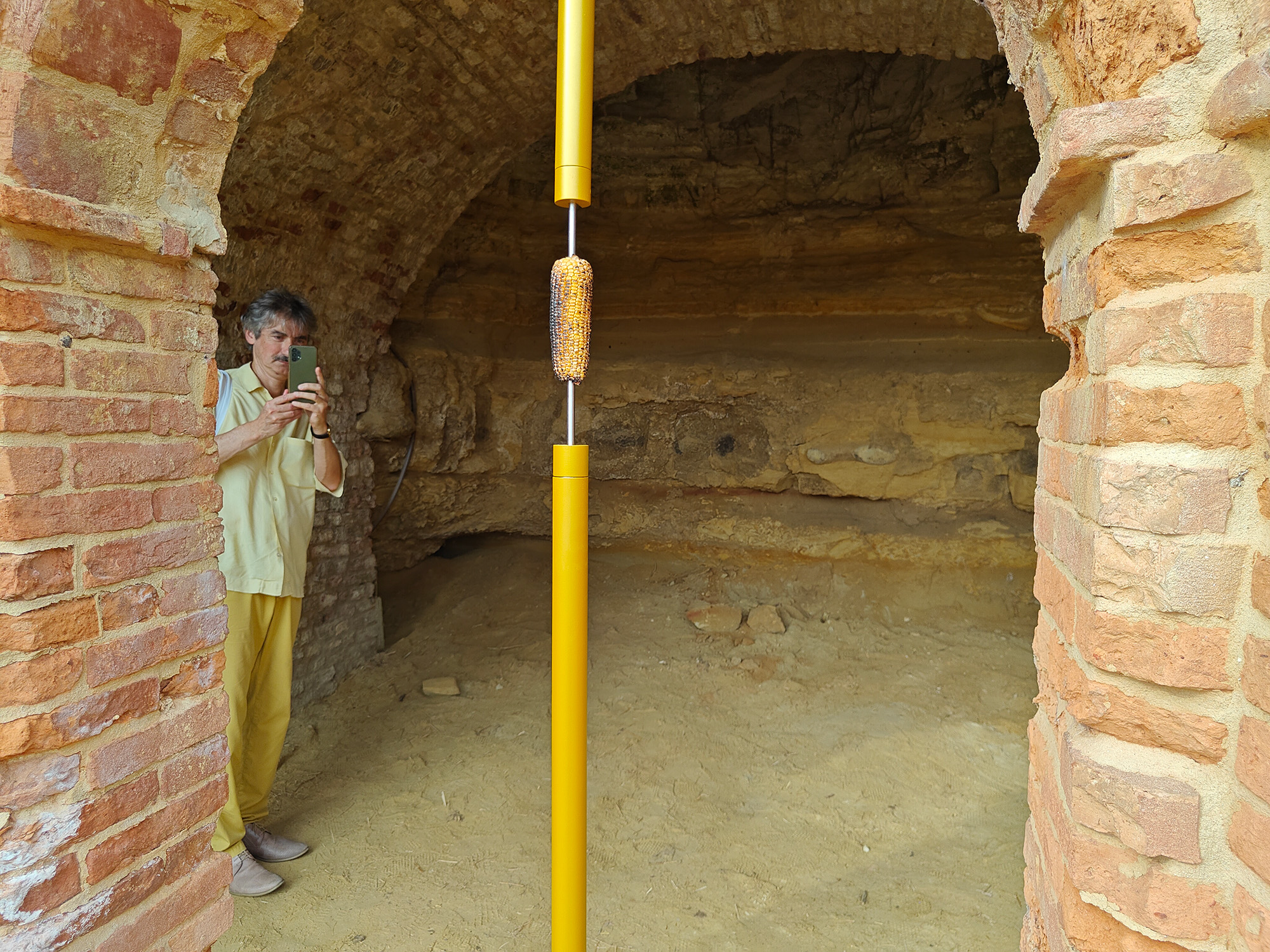





A suite of drawings from the collective Atelier dell’Errore,
who also featured prominently in the recent Biennale Gherdeina (00216) followed
the staircase upwards, leading to a second floor loggia, replete with a newly
laud mirrored floor from Alfredo Pirri. When Passi (2024) was installed,
the mirror was intact, but each time a visitor steps across it, new splinters
and cracks form. The reflected arched space glows and invites passage to the end
in order to reach views across the landscape, but in doing so forces the
visitor to step with anxiety, knowingly damaging the work, the sharp noises
piercing with every movement.
CAMAGNA
The theme of “work” is present in the first work encountered in Camagna, a swirling vortex of sculpture by Gianpietro Carlesso, suspended midway along an arched loggiato of the Palazzo Communale. Tutto muta (2013) is created form a single sheet of Corten steel, industrially machined into a concept of infinity, capturing fluidity in its solidity and calling back to the region’s industrial heritage.
Over two floors of a nearby building the theme continues. While the Piedmont region is recognised for its pastoral calm, romantic views, and classical histories, the works here remind that it is also a place and people rooted in making and material processes. This is explicitly presented with Arcangelo Sassolino’s The paradoxical nature of life (2023), comprising a 280kg anvil resting on a precariously bending sheet of glass. It sits in front of an altar of a small chapel, presenting strong allegorical suggestion but also with strong material presence.
The theme of “work” is present in the first work encountered in Camagna, a swirling vortex of sculpture by Gianpietro Carlesso, suspended midway along an arched loggiato of the Palazzo Communale. Tutto muta (2013) is created form a single sheet of Corten steel, industrially machined into a concept of infinity, capturing fluidity in its solidity and calling back to the region’s industrial heritage.
Over two floors of a nearby building the theme continues. While the Piedmont region is recognised for its pastoral calm, romantic views, and classical histories, the works here remind that it is also a place and people rooted in making and material processes. This is explicitly presented with Arcangelo Sassolino’s The paradoxical nature of life (2023), comprising a 280kg anvil resting on a precariously bending sheet of glass. It sits in front of an altar of a small chapel, presenting strong allegorical suggestion but also with strong material presence.
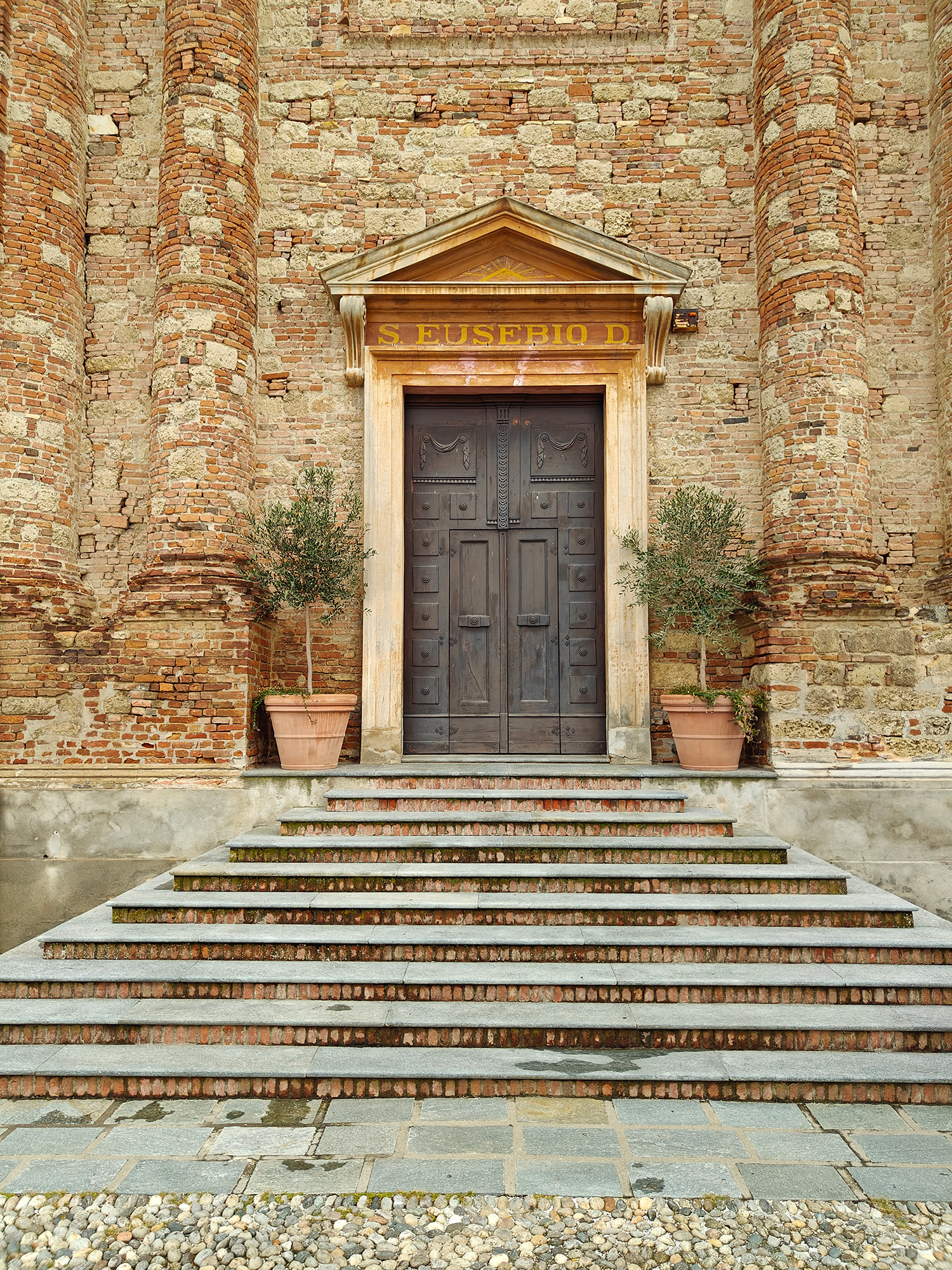









There are another 21 works across an excellently curated
suite of spaces, all speaking to craftsmanship in variously abstract ways. Armando
Andrade Tudela’s stainless steel skins are suspended of metal bars, presenting
as somewhere between luxury jewellery presented in a boutique and flayed
carcases in a butchers. Several of Richard Meitner’s absurd objects are also to
be found, weird amalgams of glass, lacquer, iron, resin, aluminium and other
industrial processes. The artist refers to the pieces as drawings, of materials
in space rather than pencil on paper. Found objects lock onto fabricated
extensions, function adorns play, meaning is dialectically tied to nonsense.
Mangrove-like growths emerge from black pools in Binta Diaw’s sculptures of synthetic hair and iron. Historical roots reaching skywards for something new, turning an empty kitchen into a place of nature and manmade material dancing together. Leaning against the wall are photographs by Moira Ricci of abandoned houses in the Maremma region of central Italy, the artist editing out doors and windows to turn them into solid sculptures speaking to processes of removal and loss.
Mangrove-like growths emerge from black pools in Binta Diaw’s sculptures of synthetic hair and iron. Historical roots reaching skywards for something new, turning an empty kitchen into a place of nature and manmade material dancing together. Leaning against the wall are photographs by Moira Ricci of abandoned houses in the Maremma region of central Italy, the artist editing out doors and windows to turn them into solid sculptures speaking to processes of removal and loss.
The prints continue next door, now as backdrop to spiralling
rope, bead, and fabric which sit as if a new undulating landscape for the
abandoned homes. The landscapes, however, are of unknown scale – these could be
agricultural, termite-like, regional, or even astronomical, with the individual
peaks reading as if evolving, naturally forming structures trying to grow
upwards before collapsing under their own weight, woven by Brazilian Maria Nepomuceno.
Leaving Camagna, the repeating motif of a haystack wraps around a bend in the road. Lala Meredith-Vula’s print 50 reasons why nature is important: looking at the sky (2024) would normally be seen from a moving vehicle, the repeating image flickering by like frames of a motionless film, asking an audience to keep focus of what might be important however fast the journey.
Leaving Camagna, the repeating motif of a haystack wraps around a bend in the road. Lala Meredith-Vula’s print 50 reasons why nature is important: looking at the sky (2024) would normally be seen from a moving vehicle, the repeating image flickering by like frames of a motionless film, asking an audience to keep focus of what might be important however fast the journey.







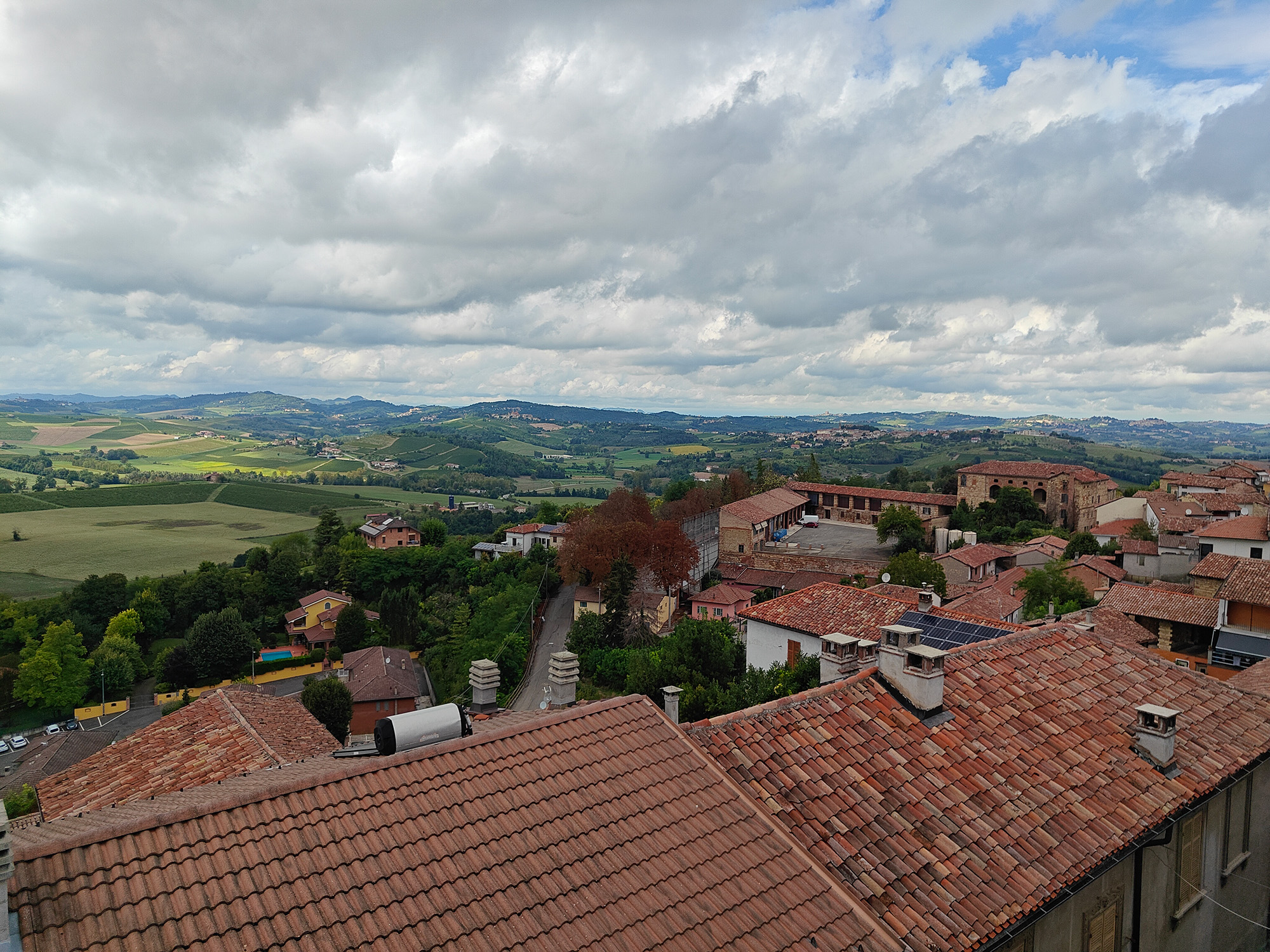
VIGNALE
One of the main presentations of Panorama was in the Palazzo Callori in Vignale, an grand 18th century home. The ancient name of the settlement is Vinealis and it is still a centre of the region’s wine production – in fact, after the Callori family died out in the 1970s, the municipality took over the Palazzo, with its historic cellars dug into the rock becoming a regional wine shop.
For ITALICS, its grand rooms were dedicated to works exploring portrait and identity – though this isn’t always a traditional portrait depiction. Elisabetta di Maggio’s Rape (2001) confronts the visitor upon entry, a weighty title for a work that at first appears gentle and soft, laying as it is across the entrance floor. A grid of Marseille soap bars repeats as a minimalist form, some are left with the Sole brand while others are hand-carved with words reflecting violence to the body: blood, sweat, semen, urine, tears.
One of the main presentations of Panorama was in the Palazzo Callori in Vignale, an grand 18th century home. The ancient name of the settlement is Vinealis and it is still a centre of the region’s wine production – in fact, after the Callori family died out in the 1970s, the municipality took over the Palazzo, with its historic cellars dug into the rock becoming a regional wine shop.
For ITALICS, its grand rooms were dedicated to works exploring portrait and identity – though this isn’t always a traditional portrait depiction. Elisabetta di Maggio’s Rape (2001) confronts the visitor upon entry, a weighty title for a work that at first appears gentle and soft, laying as it is across the entrance floor. A grid of Marseille soap bars repeats as a minimalist form, some are left with the Sole brand while others are hand-carved with words reflecting violence to the body: blood, sweat, semen, urine, tears.
Diego Perrone’s abstracted glass sculptures appear to be melting,
one side as a swirl of marbling colour, the other revealing recognisable if
distorted forms, like a hazy memory or miscommunication. 1934 portraits by
Ottone Rosai look down from the walls, everyday folk treated like palazzo
owners.
Next door, interrupting deep views across the Piedmont landscapes, Salvatore Astore’s steel Anatomia Umana sculptures (2023). A fracture through one could relate to seismic activity in the land or damage to a bone, but seemingly adds character rather than presents a weakness or imperfection. These monoliths seem to be struggling to act as a mirror, allowing the viewer to see themselves within the welded anatomy, but the welded surfaces softens exactitude.
Next door, interrupting deep views across the Piedmont landscapes, Salvatore Astore’s steel Anatomia Umana sculptures (2023). A fracture through one could relate to seismic activity in the land or damage to a bone, but seemingly adds character rather than presents a weakness or imperfection. These monoliths seem to be struggling to act as a mirror, allowing the viewer to see themselves within the welded anatomy, but the welded surfaces softens exactitude.
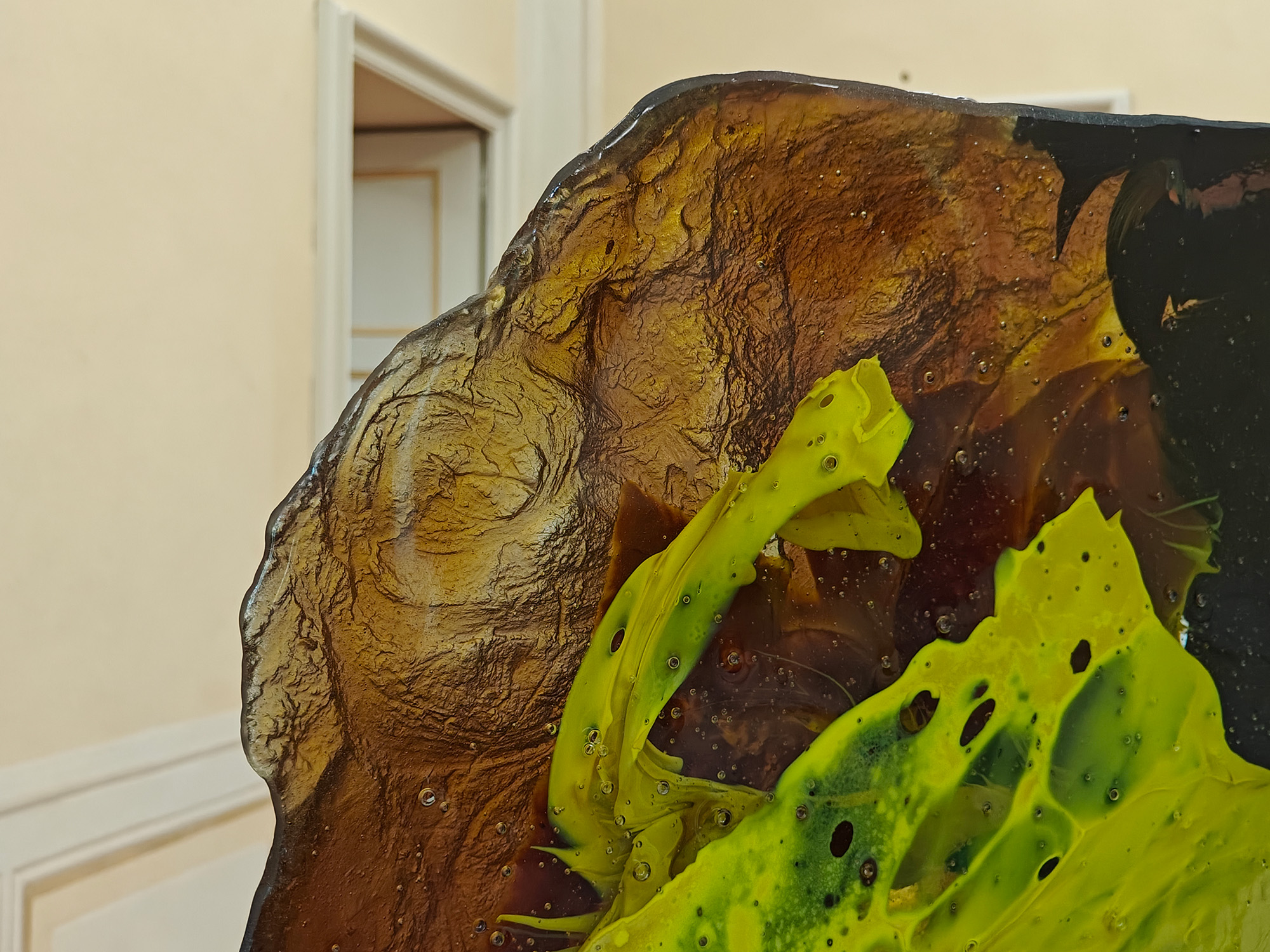


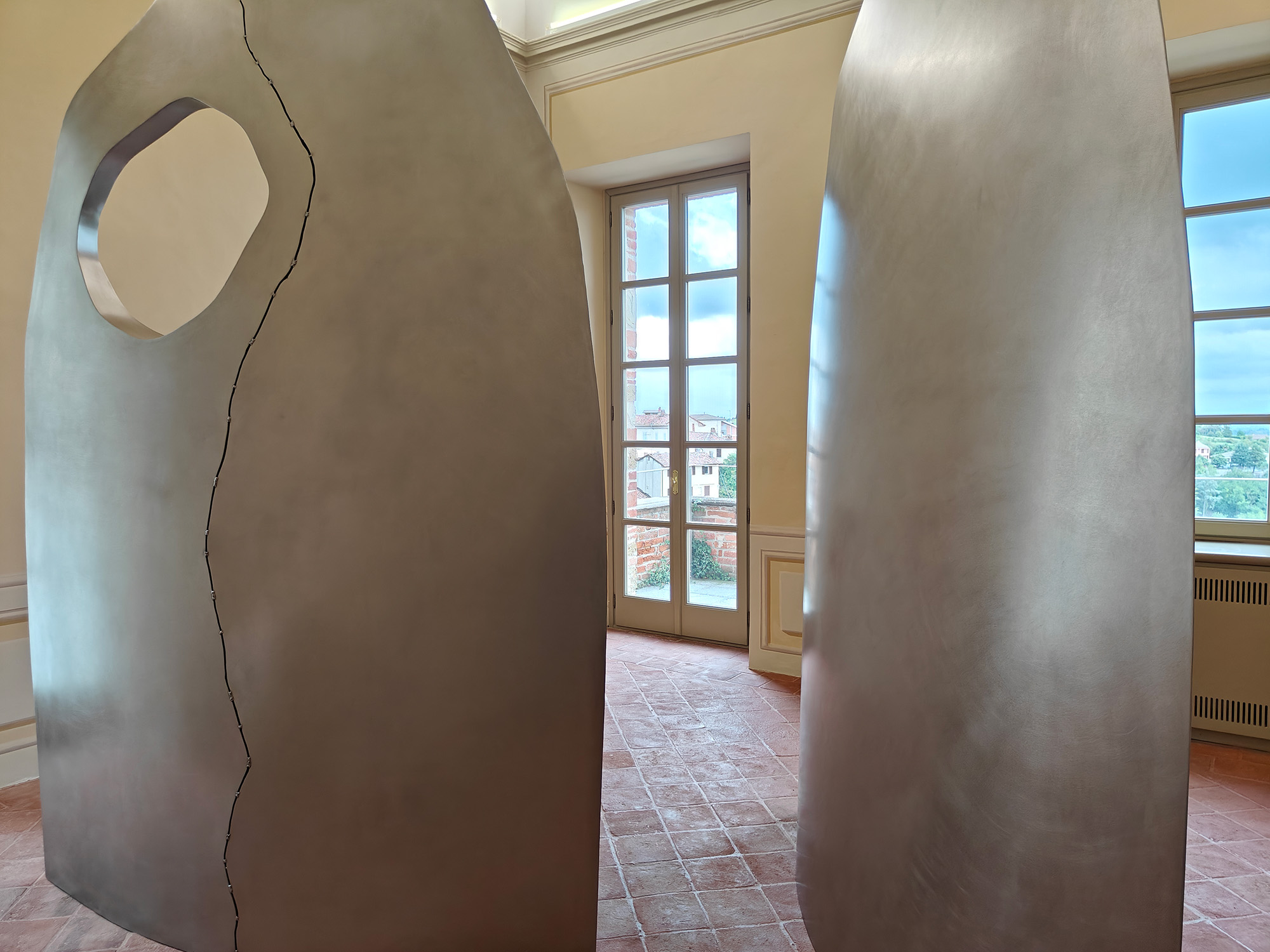
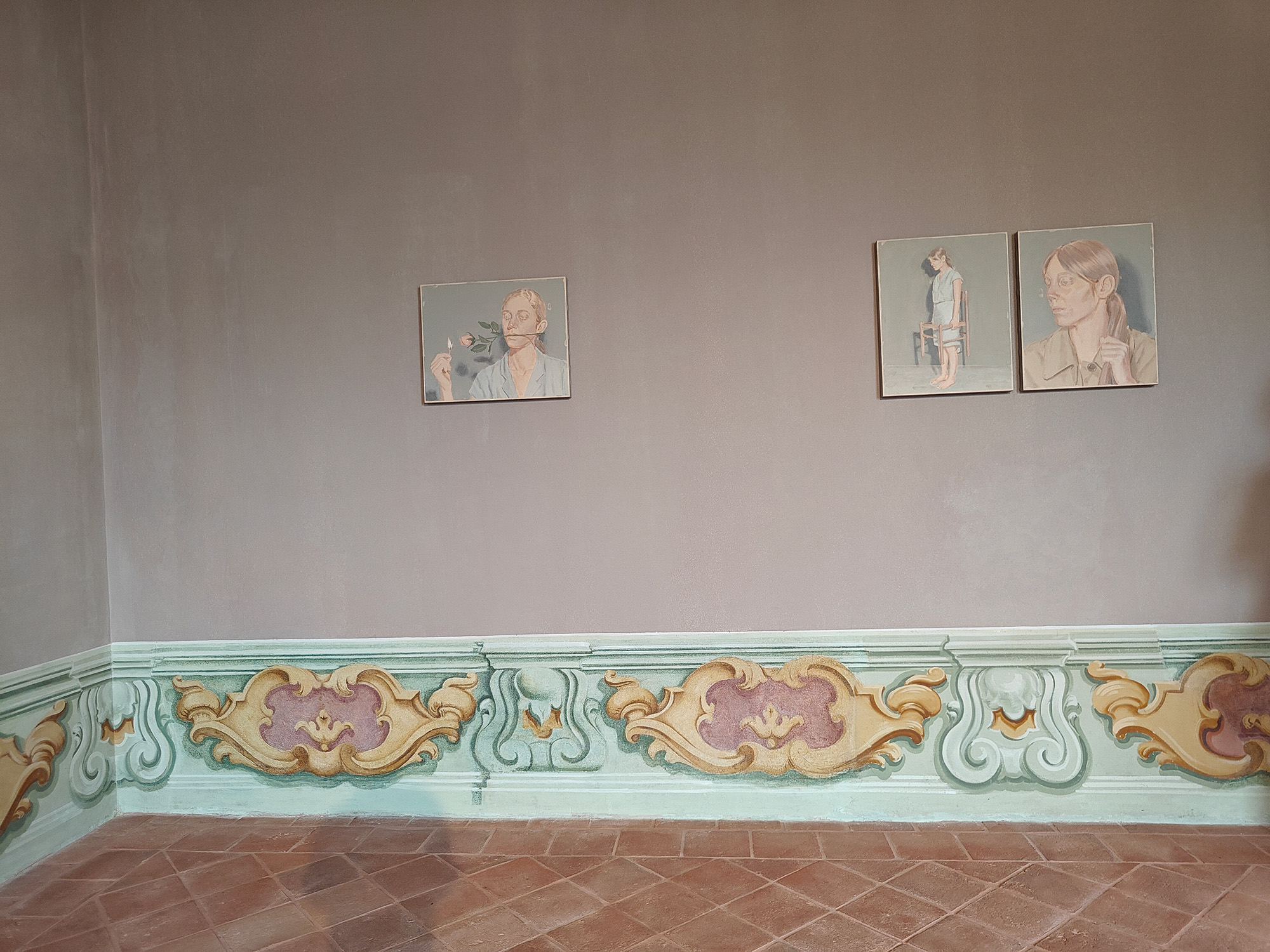


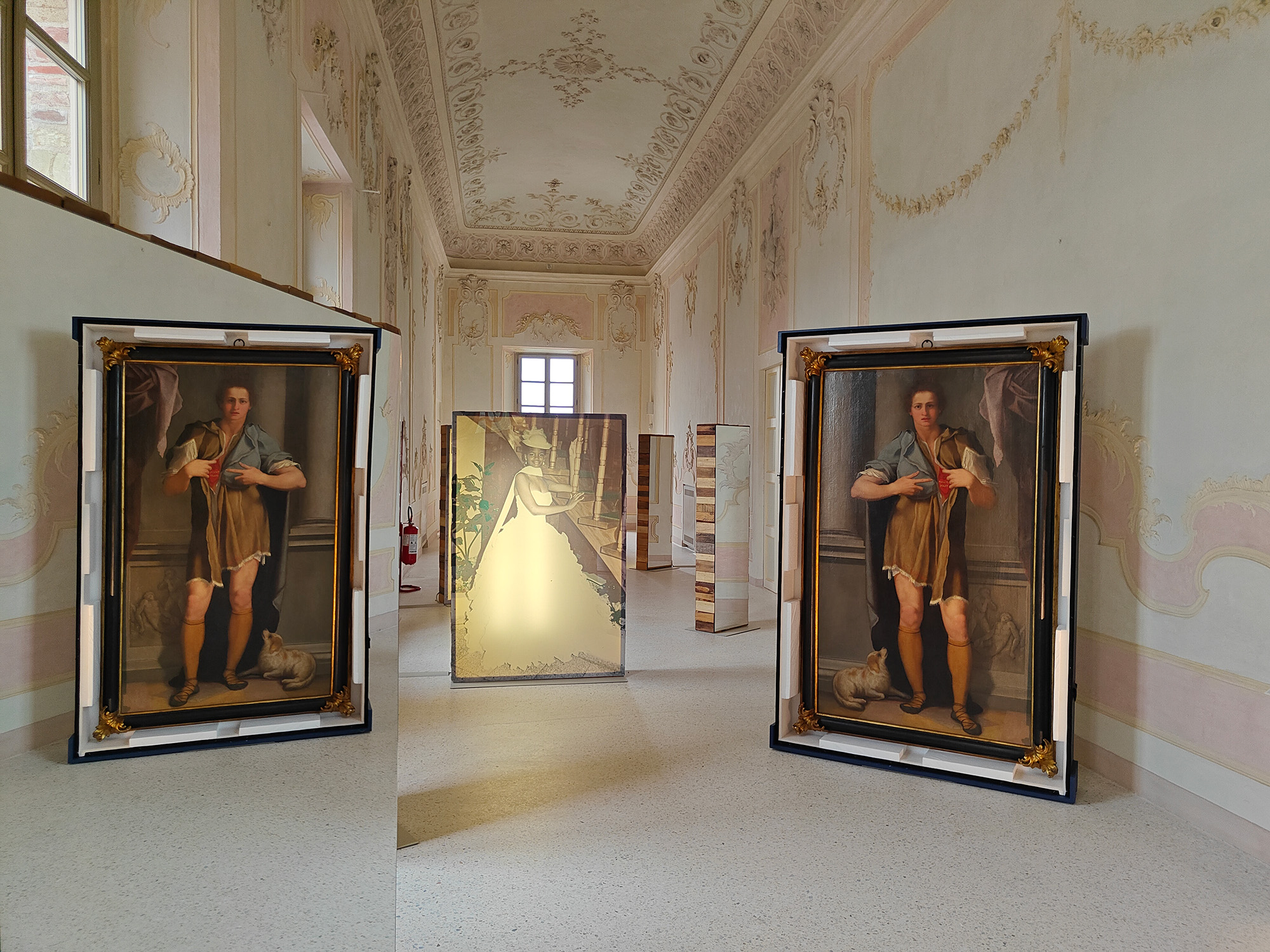
Encased within a space of ornate pastel-pink decoration,
Susana Pilar’s life-size lightbox photographs are arranged to be in
conversation with each other and a visitor’s path around. The people in each
are the artist and female family members going back to her great grandmother,
dressed as brides at 15 years old for a Cuban traditional moment. Mirrors to
the reverse cause reflections of the public to mingle with Pilar’s past, while
a 16th century oil painting by Mirabello Cavalori of a young man
opening his chest to reveal the heart, an image loaded with symbolism also tied
to love and romance. In proximity to Pilar’s images, the distance between the
works is explored, and how identity, who is depicted when, and how they reveal
themselves.
Within such ornate decoration of the palazzo, art can work to fight for dominance or more gently work with the conditions. So it is with Romina Bassu’s seven acrylic paintings made for this exhibition. A female figure is seen in silent moments, removed and in semi-hiding, perhaps questioning consent in the portrait and with a sense of withdrawal into the soft tones of the wall.
Within such ornate decoration of the palazzo, art can work to fight for dominance or more gently work with the conditions. So it is with Romina Bassu’s seven acrylic paintings made for this exhibition. A female figure is seen in silent moments, removed and in semi-hiding, perhaps questioning consent in the portrait and with a sense of withdrawal into the soft tones of the wall.
Altogether more present in the space are Markus Schinwald’s
awkward Sacks series next door, with a Chippendale-style table seemingly
trapped within baroque folds of fabric, spindly deer legs struggling against
enclosure. A portrait titled Emma (2016) hangs above the fireplace, giving a
sense of domestic order equally struggling to hold itself despite the
surrounding chaotic breakdown of logic.
The subject of identity continues in one other Vignale building off a lane down the side of Palazzo Callori, the Chiesa dei Battuti. Afforded the whole church for his work, Patrick Tuttofuoco presents two works. In the centre of the room, Pink Limen (2024) is a 3D scan of the artist, collapsed and headless, as if now a lifeless casing melted into the space. In such religious architecture, the body here cannot but take on a connection to identity beyond the flesh, lit as it is by a pink neon light shaped into a silhouette of a man, alluding to a transfiguration or shift of identity to a new space.
The subject of identity continues in one other Vignale building off a lane down the side of Palazzo Callori, the Chiesa dei Battuti. Afforded the whole church for his work, Patrick Tuttofuoco presents two works. In the centre of the room, Pink Limen (2024) is a 3D scan of the artist, collapsed and headless, as if now a lifeless casing melted into the space. In such religious architecture, the body here cannot but take on a connection to identity beyond the flesh, lit as it is by a pink neon light shaped into a silhouette of a man, alluding to a transfiguration or shift of identity to a new space.





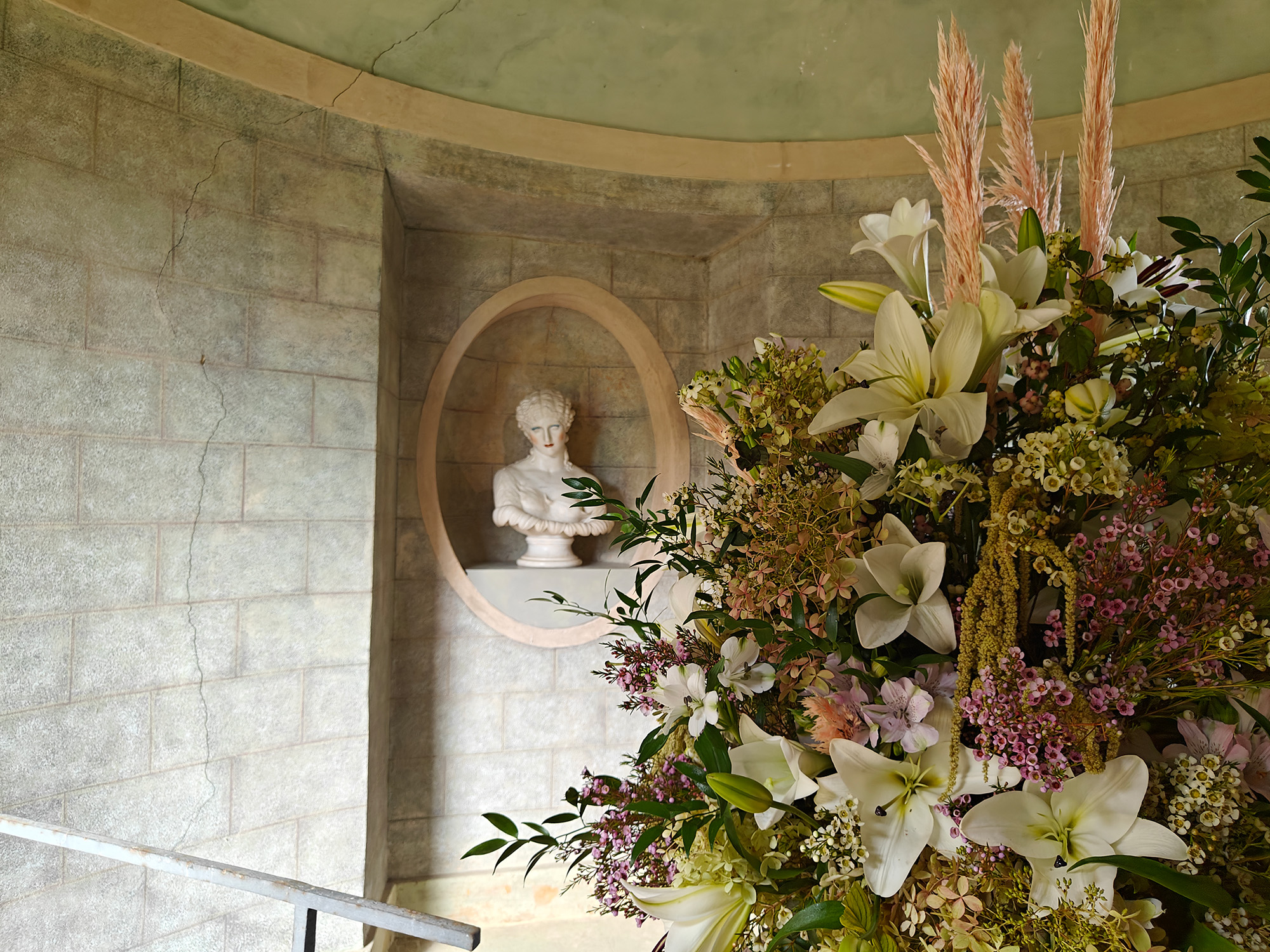

MONTEMAGNO
The Castello de Montemagno is perhaps the most sublime and immense space for any of the Panorama presentations, but before descending into the cavernous bowels of the medieval fortress the work starts at a more subtle scale.
Two Francesco Vezzoli marble busts sit in oval recesses within a small outbuilding constructed into defensive walls, their classical appearance broken by Chanel and Dior makeup applied to the otherwise monochrome faces. Camp and satirical, it starts an exploration of ageing and death, though these stone characters will now never age, beautified and petrified.
The Castello de Montemagno is perhaps the most sublime and immense space for any of the Panorama presentations, but before descending into the cavernous bowels of the medieval fortress the work starts at a more subtle scale.
Two Francesco Vezzoli marble busts sit in oval recesses within a small outbuilding constructed into defensive walls, their classical appearance broken by Chanel and Dior makeup applied to the otherwise monochrome faces. Camp and satirical, it starts an exploration of ageing and death, though these stone characters will now never age, beautified and petrified.
A winding, tightening staircase leads to the castle’s
subterranea, architectures that carry the weight of the past with solidity and
strength. Accessed via the stone moat under the drawbridge, deep vaulted spaces
offer an atmospheric temporary home for Italics’ artworks.
The folds of Latifa Echakhch’s theatre backdrop play against the brickwork, the view of mountains from Lausanne collapsing into a pile on the floor under pressure from the sky and castle above. The golden hour glowing across one side of the clouds and peaks marries with the patina of the space, adding a tinge of hope to the otherwise brooding darkness of shadows.
The folds of Latifa Echakhch’s theatre backdrop play against the brickwork, the view of mountains from Lausanne collapsing into a pile on the floor under pressure from the sky and castle above. The golden hour glowing across one side of the clouds and peaks marries with the patina of the space, adding a tinge of hope to the otherwise brooding darkness of shadows.



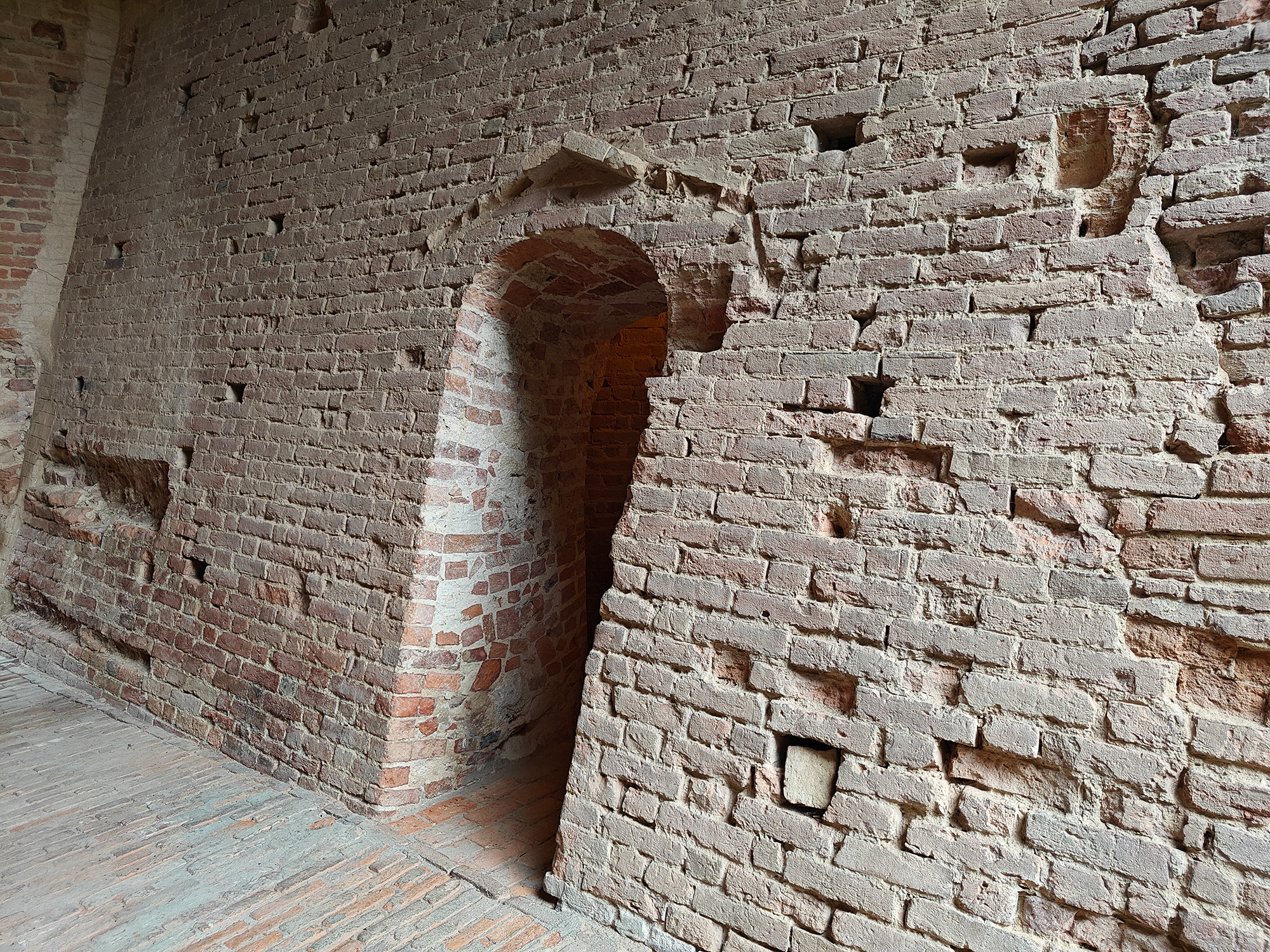

A 17th century painting by an artist known as
Giusepepe Cesari, possibly the final work of a painter who was a pupil of
Caravaggio, portrays the violence of a battle contemporary to the surrounding fortified
architecture. Bodies compress into the scene, contorted and collapsed in
struggle or death, animal and human as one within a work that could be read as
far more modern than it is.
Facing, in procession, several of Marianne Vitale’s Bottle People – liquor bottles wrapped in fabric then cast in bronze – might be chaotically marching into battle, or maybe fleeing from.
Facing, in procession, several of Marianne Vitale’s Bottle People – liquor bottles wrapped in fabric then cast in bronze – might be chaotically marching into battle, or maybe fleeing from.
In this basement, the brick alcoves with gradating light
carry an ecclesiastical feel. Within one, a projected film pushes this further,
though with a sense of despair and closure that perhaps befits its viewing as
the final work of Italics. Gone Art the Days of Shelter and Martyr is a short
2014 film from Chicagoan Theaster Gates, made within the ruined carcass of St.
Laurence Catholic Church in the city’s South Side.
In an act of remembrance for the erasure of architectural spaces speaking to the communities and politics that they once housed, the artist and The Black Monks, his music ensemble, perform in the space with percussion and gospel. As a secular ritual, it speaks beyond religiosity and towards the lost social, cultural, architectural, and political qualities that such spaces offered, though fills the ruin with a hope.
In an act of remembrance for the erasure of architectural spaces speaking to the communities and politics that they once housed, the artist and The Black Monks, his music ensemble, perform in the space with percussion and gospel. As a secular ritual, it speaks beyond religiosity and towards the lost social, cultural, architectural, and political qualities that such spaces offered, though fills the ruin with a hope.



ITALICS promotes the culture and beauty of Italy through a national network of gallerists working together and sharing experiences, on and offline, with an international audience of collectors and art lovers. ITALICS is a consortium of more than seventy of Italy’s most influential galleries of contemporary, modern and ancient art.
The concept as a whole is the brainchild of Lorenzo Fiaschi (Galleria Continua), president of ITALICS and Pepi Marchetti Franchi (Gagosian), vice president of ITALICS, who came up with the idea in the spring of 2020 together with founding members Alfonso Artiaco, Ludovica Barbieri (Massimo De Carlo), Massimo Di Carlo (Galleria dello Scudo), Francesca Kaufmann (kaufmann repetto), Massimo Minini, Franco Noero and Carlo Orsi.
Panorama is the special event ITALICS periodically holds in some of the most extraordinary places in the Italian landscape. Panorama is a unique exhibition experience that brings the ancient, modern and contemporary, styles, techniques and multifaceted approaches together in art itineraries designed to reveal the more authentic but obscure aspects of our country, a live continuation of the extraordinary journey launched in 2020 on this platform.
Following the first edition in 2021 on the island of Procida, and the second, in 2022, in Monopoli, Puglia, both curated by Vincenzo de Bellis, Panorama 2023 was held in L’Aquila, Abruzzo, curated by Cristiana Perrella. The fourth edition of Panorama will take place from September 4 to 8, 2024, in Monferrato, Piedmont, curated by Carlo Falciani.
www.italics.art/en
Will Jennings is a London based writer, visual artist, and educator interested in cities, architecture, and culture. He has written for the RIBA Journal, the Journal of Civic Architecture, Quietus, The Wire, the Guardian, and Icon. He teaches history and theory at UCL Bartlett and Greenwich University, and is director of UK cultural charity Hypha Studios.
www.willjennings.info
www.willjennings.info
more informationThe host location for the next ITALICS Panorama will be announced early next year. For further information please visit: www.italics.art/en
The main partner of ITALICS Panorama is Belmond, with sponsorship from Intesa SanPaolo, Poste Italiane & Forma. The event is under the patronage of Unesco, the Ministero della Cultura & Regione Piemonte.
images
All photographs © Will Jennings.
publication date
24 November 2024
tags
A arte Invernizzi, Salvatore Astore, Atelier dell’Errore, Romina Bassu, Camagna, Cardi Gallery, Gianpietro Carlesso, Carlo Orsi, Catagnole, Caterina Tognon Arte Contemporanea, Mirabello Cavalori, Giusepepe Cesari, Binta Diaw, Elisabetta di Maggio, Latifa Echakhch, Maria Elisabetta, Federica Schiavo Gallery, Francesca Minini, Gagosian, Galleria Canesso, Galleria Continua, Galleria d’Arte Frediano Farsetti, Galleria dello Scudo, Galleria Doris Ghetta, Galleria Franco Noero, Galleria Fumagalli, Theaster Gates, Gió Marconi, ITALICS, Italy, Invernomuto, Will Jennings, Kaufmann Repetto, Laveronica Arte Contemporanea, Maurizio Nobile Fine Art, Mazzoleni, Richard Meitner, Fausto Melotti, Lala Meredith-Vula, ML Fine Art, Monferrato, Montemagno, Giorgio Morandi, Maria Nepomuceno, Massimodecarlo, P420, Panorama, Claudio Parmiggiani, Diego Perrone, Piedmont, Susana Pilar, Pinksummer, Alfredo Pirri, Prometeo Gallery Ida Pisani, Moira Ricci, Richard Saltoun Gallery, Ottone Rosai, Arcangelo Sassolino, Markus Schinwald, Simóndi, Studio Sales di Norberto Ruggeri, Studio Trisorio, Tornabuoni Arte, Tucci Russo Studio per l’Arte Contemporanea, Armando Andrade Tudela, Patrick Tuttofuoco, Pieter Vermeersch, Michel Verjux, Francesco Vezzoli, Victoria Miro, Vignale, Marianne Vitale
The main partner of ITALICS Panorama is Belmond, with sponsorship from Intesa SanPaolo, Poste Italiane & Forma. The event is under the patronage of Unesco, the Ministero della Cultura & Regione Piemonte.


